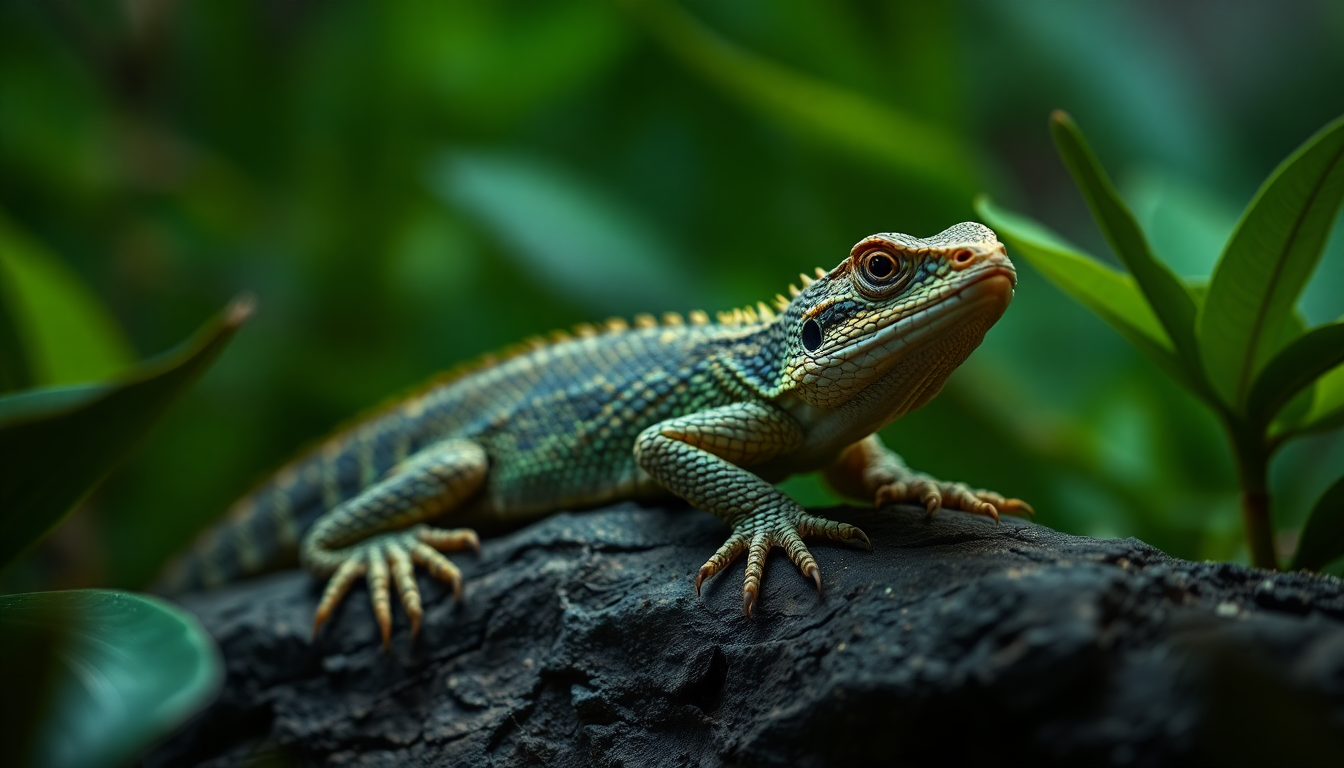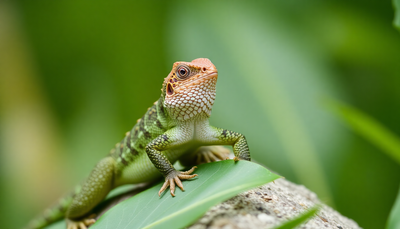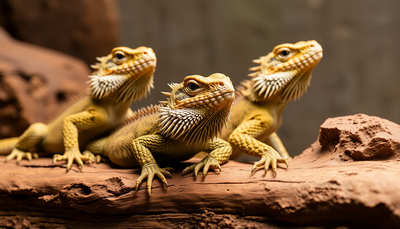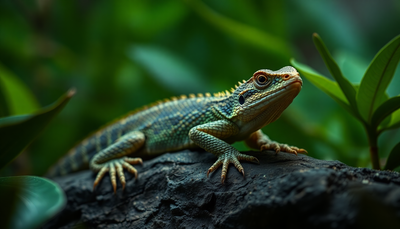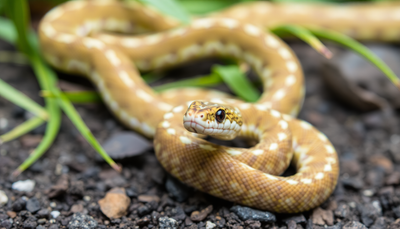Key Takeaways:
- Introduction
- What are UVB Bulbs?
- T5 UVB Bulbs: An Overview
- T8 UVB Bulbs: An Overview
- Output Power and Effectiveness
- Lifespan and Durability
- Energy Efficiency
- Installation and Compatibility
- Choosing the Right Bulb for Your Reptile
- Common Myths and Misconceptions
The Importance of UVB Lighting for Reptiles
Understanding the profound impact of UVB lighting on reptile health is fundamental for any dedicated reptile enthusiast. UVB light is essential for facilitating the synthesis of vitamin D3, which is crucial for calcium absorption. Without proper UVB exposure, reptiles can suffer from metabolic bone disease, leading to severe health complications. Therefore, ensuring your reptile receives the proper amount of UVB light is not just beneficial but vital for their overall well-being.
Why UVB Lighting Matters
Reptiles, being ectothermic creatures, rely on external heat sources to regulate their body temperature. Proper UVB exposure contributes to their behavioral health and stress reduction, promoting natural behaviors like basking. In a captive environment, replicating their natural habitat as closely as possible—including the right UVB bulbs—is key to ensuring their health and vitality.
Overview of T5 and T8 UVB Bulbs
When selecting the best UVB bulbs for reptiles, hobbyists often debate between T5 UVB bulbs and T8 UVB bulbs. Both types cater to the lighting needs of reptiles, but they differ significantly in terms of efficiency and output. T5 bulbs are known for their higher UVB output and increased efficiency, which can prove crucial for larger enclosures or species with higher UVB requirements. On the other hand, T8 bulbs, while less powerful, may still serve well in smaller habitats or for species that require lower UVB intensities.
Comparing T5 and T8 Bulbs in 2025
As we move into 2025, advancements in reptile lighting technology have prompted a deeper examination of the reptile lighting comparison between T5 and T8 bulbs. Enhanced manufacturing processes have improved the performance and durability of these bulbs, making it vital for reptile owners to stay informed. This guide aims to provide clarity on these differences, ultimately helping you make an informed decision that best supports your reptile's health needs.
In conclusion, this section has laid the groundwork for understanding the critical role of UVB lighting in reptile care and the focus of our upcoming comparison between T5 and T8 UVB bulbs. By grasping these foundational concepts, you're better prepared to navigate the complex world of UVB lighting for reptiles, ensuring a more prosperous pet-keeping experience.
What are UVB Bulbs?
When discussing reptile care, understanding the role of UVB bulbs is crucial for the health and well-being of your pets. These bulbs are a critical component of any reptile habitat, providing essential light that mimics natural sunlight. This section explores the definition of UVB bulbs, their particular purpose in reptile care, and the distinctions between UVA and UVB rays.
Understanding UVB Bulbs
UVB bulbs are designed to emit ultraviolet B light, which is a specific wavelength of UV radiation essential for reptiles. Unlike standard light bulbs, UVB bulbs produce light in the UV spectrum that facilitates the synthesis of vitamin D3 in reptiles. This vitamin is essential for the uptake of calcium, preventing metabolic bone diseases - a common and often fatal condition in reptiles that do not receive adequate UVB exposure.
"UVB exposure is vital for the health of many reptiles; without it, they cannot metabolize calcium properly." - Reptile Care Specialist
The Purpose of UVB in Reptile Care
The primary purpose of UVB bulbs in reptile care is to reproduce the effects of natural sunlight, which many reptiles rely on in the wild. This lighting promotes healthy activity levels, breeding behaviors, and proper nutritional absorption. The absence of adequate UVB light can lead to lethargic behavior and eventual health complications. Selecting the best UVB bulbs for reptiles is essential for ensuring they lead healthy lives, supporting both their physical and psychological well-being.
The Difference Between UVA and UVB Rays
Understanding the difference between UVA and UVB rays is intricate for reptile owners. While UVA rays are primarily responsible for stimulating behavior and appetite, UVB rays are much more crucial for physiological processes. UVA helps in the general well-being and activity of reptiles, whereas UVB is directly linked to health outcomes through vitamin D3 synthesis. In essence, successful reptile care incorporates both UVA and UVB light sources, with a significant emphasis on ensuring that sufficient UVB is provided.
In conclusion, the choice between T5 UVB bulbs and T8 UVB bulbs can significantly impact your reptile's health. Recognizing what UVB bulbs are and their essential roles in reptile care is the first step towards creating a thriving environment for your scaly companions. Stay tuned as we delve deeper into the specifics, comparing T5 and T8 bulbs to help you make the most informed choice.
T5 UVB Bulbs: An Overview
What Are T5 UVB Bulbs?
T5 UVB bulbs are compact fluorescent lights designed specifically for providing UVB radiation that is essential for many reptiles. They are called "T5" because of their diameter, which measures 5/8 of an inch. This *narrow design* allows for a brighter output and more efficient use of energy compared to traditional fluorescent bulbs such as T8 UVB bulbs. The optimal wavelength produced by T5 bulbs typically ranges from 290-320nm, which is critical for the synthesis of Vitamin D3 in reptiles and vital for their overall health.
Key Characteristics of T5 UVB Bulbs
One of the most critical features of T5 UVB bulbs is their higher UVB output in comparison to other types. They generally produce more UVB energy per watt, making them a preferred choice for reptile lighting comparisons. Furthermore, their lifespan is relatively long, often up to 12 months before replacement is necessary, ensuring consistent light and UVB exposure.
Additionally, T5 bulbs come in various wattages, allowing reptile owners to choose the perfect bulb for their specific needs. Depending on your reptile species and its habitat requirements, a 24W or 39W bulb could be beneficial, delivering essential UVB while promoting healthy behaviours such as basking.
Benefits of Using T5 UVB Bulbs
T5 UVB bulbs offer multiple benefits that contribute to the well-being of your reptiles. First and foremost is the enhancement of their metabolic rates. By providing adequate UVB exposure, reptiles are able to synthesize Vitamin D3 more efficiently, which can lead to improved calcium absorption. This is crucial in preventing metabolic bone disease, a common ailment in reptiles kept in captivity.
Moreover, their ability to produce bright light not only mimics natural sunlight but also helps in stimulating natural behaviours such as basking and activity levels. This can ultimately lead to a more lively and interactive pet. Another benefit is their energy efficiency, which aligns with modern sustainability practices, ensuring you light your reptile habitat without excessive energy use.
Typical Usage Scenarios for Reptiles
When it comes to typical usage scenarios for T5 UVB bulbs, these bulbs are particularly effective for species requiring higher levels of UVB exposure, such as bearded dragons, green iguanas, and several types of tortoises. For these reptiles, a basking area should be located close enough to the bulb to ensure they receive adequate UVB light, usually within the range of 12-18 inches.
In contrast, reptiles that require lower UVB exposure, like some *creeping lizards* or *snakes*, can also benefit from T5 bulbs but should be placed at a greater distance to prevent UVB overexposure. A comprehensive reptile care guide would emphasize the need to customize the lighting setup according to the specific requirements of each species. Careful consideration of factors such as housing type, UVB bulb strength, and distance will create an optimized habitat for your reptiles.
In summary, T5 UVB bulbs are a fantastic option for reptile owners looking to provide the best lighting solutions for their pets. With their superior output, lifespan, and energy efficiency, these bulbs have secured their place as a top choice in the realm of reptile care.
T8 UVB Bulbs: An Overview
As we explore the world of reptile lighting, it's crucial to delve into T8 UVB bulbs, which serve a fundamental role in creating a healthy environment for our scaly companions. Known for their reliability and efficiency, T8 bulbs are a popular choice among reptile keepers.
Features of T8 UVB Bulbs
T8 UVB bulbs are characterized by a diameter of one inch and are typically four feet long. Their design allows for an optimal balance of both UVB radiation and visible light. One of the defining features of these bulbs is their ability to emit UVB rays at wavelengths that are essential for the synthesis of Vitamin D3 in reptiles, promoting calcium metabolism and preventing metabolic bone disease.
“Proper lighting is essential for the wellbeing of reptiles, and T8 UVB bulbs are often the first choice due to their effective UV output.”
Advantages of T8 UVB Bulbs
One major advantage of using T8 UVB bulbs is their cost-effectiveness. They are generally more affordable than their T5 counterparts, making them accessible for all reptile enthusiasts. Additionally, T8 bulbs are easy to find in pet stores, and many suppliers offer a variety of options tailored to the specific needs of different reptile species.
Another noteworthy feature is their lifespan. T8 UVB bulbs can last up to 12 months, providing consistent UVB output without the need for frequent replacements, thus making them a practical choice for reptile habitats. Furthermore, their versatile design allows them to fit into a variety of fixtures, ensuring compatibility with many common setups.
Common Applications in Reptile Habitats
T8 UVB bulbs are widely used in the habitats of different reptiles, including desert species like bearded dragons, as well as forest dwellers such as iguanas. The ability to provide adequate UVB exposure helps these reptiles synthesize Vitamin D3 efficiently, which is crucial for their overall health and vitality.
For\/illuminating larger enclosures, multiple T8 UVB bulbs can be utilized in conjunction with other types of lighting, creating a balanced environment that mimics natural sunlight. This not only supports the physical health of the reptiles but also encourages natural behaviors and promotes a more enriching habitat.
In summary, T8 UVB bulbs present a robust solution for reptile keepers seeking to enhance their reptile care guide. With their effective UVB output, long lifespan, and affordability, they allow for proper lighting setups that cater to the diverse needs of reptiles.
Output Power and Effectiveness
The choice between T5 UVB bulbs and T8 UVB bulbs essentially boils down to a crucial factor: their output power and effectiveness in delivering necessary UVB radiation to reptiles. Each type of bulb is constructed differently, which influences its penetration and overall efficiency in providing the necessary light that reptiles thrive on. Let's delve into the comparison of these two UVB bulb types to understand their performance better.
Understanding Output Power
Output power is a fundamental characteristic that influences how much UVB light reaches your reptiles. T5 UVB bulbs generally emit a higher output compared to T8 UVB bulbs. Specifically, T5 bulbs can produce around 50% more UVB radiation, making them suitable for larger enclosures or species that require intense UV exposure.
UVB Penetration and Delivery
Another aspect to consider is the UVB penetration through the habitat. Due to their higher intensity and superior design, T5 UVB bulbs can effectively penetrate deeper into the enclosure setup, providing a more uniform light distribution. This is vital for reptiles who rely on UVB exposure for vitamin D3 synthesis and overall health.
Heat Output and Reptile Comfort
It’s essential to note that higher output power doesn't only correlate with UVB effectiveness; it also brings heat output into the equation. T5 UVB bulbs generate slightly more heat than T8 bulbs, which might affect the temperature regulation within the habitat. When choosing the best UVB bulbs for reptiles, it's crucial to factor in how much heat will be produced and its potential impact on your reptiles’ comfort.
Practical Use and Longevity
Longevity is another critical attribute to consider in our reptile lighting comparison. Typically, T5 UVB bulbs last longer than T8 bulbs, providing sufficient UVB output across their lifespan, making them a better investment in the long run. While T8 bulbs may initially seem more economical, their shorter lifespan could incur additional costs over time.
Efficiency Overview
| Bulb Type | Output Power | UVB Penetration | Heat Output | Longevity | Best Candidates |
|---|---|---|---|---|---|
| T5 UVB Bulbs | High | Deep Penetration | Moderate | 12-18 Months | Larger species, high UVB needs |
| T8 UVB Bulbs | Lower | Shallow Penetration | Low | Low | Smaller species, less UVB required |
Choosing the appropriate bulb significantly affects your reptiles' well-being. It is essential to evaluate the output power and effectiveness of each type. For a comprehensive reptile care guide, consider your reptiles' specific needs, habitat size, and UVB requirements.
Lifespan and Durability of T5 vs T8 UVB Bulbs
Understanding Lifespan and Durability
When choosing between T5 UVB bulbs and T8 UVB bulbs, lifespan and durability are crucial factors that profoundly affect your reptile’s health and well-being. While both types of bulbs emit UVB rays essential for reptiles, their longevity and resilience vary significantly, influencing your overall maintenance efforts.
Lifespan Comparison
Typically, T5 UVB bulbs are known for their extended lifespan, often ranging from 12 to 18 months, while T8 UVB bulbs usually last around 6 to 12 months. This difference can be attributed to several factors:
- Design Efficiency: T5 bulbs operate at higher efficiencies, providing more intense UVB output, which can lead to longer operational life.
- Heat Management: Due to their design, T5 bulbs produce less heat, resulting in minimized thermal stress that can shorten bulb life.
- Quality of Manufacturing: Generally, T5 bulbs are manufactured with superior materials, which can enhance their durability.
Factors Influencing Longevity
Several elements can impact the lifespan and durability of both T5 and T8 UVB bulbs. Understanding these can aid in making informed decisions for your reptile care:
- Operating Environment: High humidity levels and temperature fluctuations can negatively affect both bulb types' longevity.
- Usage Patterns: Frequent on-off cycles can decrease the lifespan of UVB bulbs, so consider using a timer for more consistent operation.
- Quality of Brand: Investing in reputable brands ensures better manufacturing quality and longer lifespan.
Maintenance Requirements
Maintenance plays a vital role in extending the life of your UVB bulbs. Here are some practical tips to ensure lasting performance:
- Regular Cleaning: Dust and debris can accumulate on the bulb surface; clean it regularly to ensure maximum UVB output.
- Replacement Timing: Monitor and schedule replacements based on recommended average lifespans to avoid dips in UVB production.
- Proper Installation: Ensure bulbs are correctly installed to prevent any undue stress on the fixtures that could lead to failures.
In summary, while both T5 UVB bulbs and T8 UVB bulbs have their advantages, the longevity and durability of T5 bulbs often make them a preferred choice for reptile owners seeking optimal care. Understanding the factors that influence these characteristics can help you make educated decisions, ultimately leading to the best UVB bulbs for reptiles in your care.
Energy Efficiency: T5 vs T8 UVB Bulbs
Understanding Energy Consumption
When it comes to selecting the right T5 UVB bulbs or T8 UVB bulbs, energy efficiency plays a crucial role in not only the overall operating costs of your lighting setup but also your environmental impact. Generally, T5 bulbs are known for their superior energy efficiency, producing more light while consuming less electricity compared to their T8 counterparts.
Comparative Energy Usage
To illustrate the energy consumption differences, let’s look at a comparison table highlighting wattage and lumens produced by each type of bulb:
| Bulb Type | Wattage | Lumen Output |
|---|---|---|
| T5 UVB Bulb | 24W | 1,800 lm |
| T8 UVB Bulb | 32W | 2,600 lm |
The Financial Impact
Over the lifetime of your lighting system, the choice between T5 and T8 bulbs can significantly impact your budget. For instance, if a T5 bulb operates at 24W and is run for an average of 12 hours a day, the monthly energy consumption would be approximately:
- 24W x 12 hours/day x 30 days = 8,640Wh or 8.64 kWh
Conversely, a T8 bulb would consume:
- 32W x 12 hours/day x 30 days = 11,520Wh or 11.52 kWh
Assuming an energy cost of $0.12 per kWh, the monthly costs would be:
- T5 Bulb: 8.64 kWh x $0.12 = $1.04
- T8 Bulb: 11.52 kWh x $0.12 = $1.38
As shown, T5 bulbs not only consume less power but also lead to a lower utility bill, illustrating why they may be a better choice for long-term reptile care.
Environmental Considerations
Beyond just savings, energy efficiency has significant environmental implications. Using T5 bulbs not only reduces the demand for energy but also the carbon footprint associated with energy production. Selecting energy-efficient lighting supports sustainability in reptile lighting comparison and helps promote a healthier environment for both your pets and the planet.
In conclusion, the evaluation of energy consumption between T5 and T8 UVB bulbs reveals that T5 bulbs provide a more efficient option. Not only do they save on operating costs, but they also offer environmental benefits that are crucial in responsible reptile care. Understanding these factors is vital for making informed decisions when choosing the best UVB bulbs for reptiles.
Installation and Compatibility
When selecting the best UVB bulbs for reptiles, understanding the installation options and compatibility of T5 and T8 UVB bulbs is crucial. This consideration can significantly influence your reptile's habitat, ensuring they receive the necessary UVB exposure while maintaining a user-friendly setup. Below, we delve into the essential factors to consider regarding installation.
Fixture Compatibility
One of the primary factors to consider when choosing between T5 UVB bulbs and T8 UVB bulbs is their fixture compatibility. Each type of bulb requires specific lighting fixtures designed to accommodate their dimensions and electrical requirements:
- T5 UVB bulbs are typically slimmer and more powerful, requiring fixtures that can handle their intensity and length. They are often housed in more modern lighting setups.
- T8 UVB bulbs are slightly thicker and longer, fitting older and more traditional fixtures commonly found in reptile enclosures.
Ensure your chosen fixture matches the specifications laid out for either bulb type to avoid issues in performance.
Mounting Options
When installing UVB bulbs, the mounting options available can impact both installation convenience and the overall effectiveness of the lighting:
- T5 UVB bulbs often come with adjustable mounting brackets, allowing for flexible positioning. This feature helps in directing the UVB rays effectively toward your reptile.
- T8 UVB bulbs may have fixed mounts, which can limit placement options. However, many older setups utilize simple clip-on mechanisms that make them easy to install with minimal fuss.
Consider the layout of your reptile habitat when choosing your bulb, ensuring the mounting option fits both your needs and space requirements.
Ease of Setup
Finally, the ease of setup is a significant factor. Both types of UVB bulbs offer their unique advantages:
- The installation process for T5 UVB bulbs generally requires a little more upfront planning due to their advanced fixtures but tends to result in better light coverage.
- T8 UVB bulbs are straightforward to set up for beginners, as they often come with compatible fixtures that fit standard reptile tank sizes.
Overall, opt for the bulb type that not only aligns with your reptile's specific lighting needs but also suits your comfort level with installation.
In conclusion, careful evaluation of the installation requirements for T5 UVB bulbs and T8 UVB bulbs will enhance your reptile's environment significantly. By understanding fixture compatibility, mounting options, and ease of setup, you'll be well on your way to providing the optimal lighting for your pet’s health and well-being.
Choosing the Right Bulb for Your Reptile
Understanding Your Reptile's Requirements
When venturing into the world of reptile lighting, one of the most crucial steps is understanding the specific needs of your reptile species. Different reptiles have varying requirements for UVB exposure, which helps them synthesize vitamin D3 and absorb calcium—a vital aspect of their overall health. For instance, desert-dwelling reptiles, such as bearded dragons, typically require stronger UVB light like that offered by T5 UVB bulbs, which can provide the necessary levels for optimal health. Conversely, forest-dwelling species might thrive with lower levels of UVB, making T8 UVB bulbs a suitable choice.
Evaluating Habitat Size and Layout
The size of your reptile’s habitat plays a significant role in selecting the appropriate UTF bulb. In larger enclosures, a single T8 UVB bulb might not provide adequate coverage, necessitating multiple bulbs or a switch to T5 UVB bulbs for a broader, more intense light spread. Remember, the closer your reptile is to the light source, the stronger the UVB exposure will be; however, positioning the light too close could result in overheating. Always ensure there are adequate cool zones within your habitat to allow your reptile to thermoregulate effectively.
Environmental Needs and Specific Care Guidelines
Beyond species and size, consider the specific environmental needs of your reptile. Factors such as temperature gradient, humidity levels, and basking spots are crucial. For reptiles that require a basking area combined with UVB exposure, the use of T5 UVB bulbs is often preferred due to their higher output and energy efficiency. Make sure to routinely monitor your habitat's conditions with reliable instruments to maintain a perfect balance, and consult comprehensive resources in your reptile care guide for specific recommendations tailored to your pet’s needs.
Consulting Products and Reviews
Lastly, before making your purchase, take the time to research the best UVB bulbs for reptiles based on user reviews, expert recommendations, and performance comparisons. Reputable brands will often provide detailed specs and suggested setups for their bulbs, allowing you to make an informed decision. By carefully following the guidelines outlined above, you can ensure that your chosen lighting enhances both the health and happiness of your reptile.
Common Myths and Misconceptions
Myth 1: T5 UVB Bulbs Are Always Better Than T8 Bulbs
One of the most prevalent misconceptions is that T5 UVB bulbs are inherently superior to T8 UVB bulbs. While T5 bulbs do provide a higher intensity of UVB light and are preferable for certain species, it's essential to consider the specific needs of your reptiles. For example, not all reptiles require the intense UVB output that T5 bulbs provide, and for some species, T8 bulbs may be perfectly adequate for their health and well-being. Understanding your reptile's particular requirements is crucial in making the right choice.
Myth 2: All Reptiles Need the Same Amount of UVB Light
Another common myth is the assumption that all reptiles have identical UVB light requirements. This statement couldn't be further from the truth! Different species have different UVB needs, primarily depending on their natural habitat. For instance, desert-dwelling reptiles may require more intense UVB than their forest-dwelling counterparts. Therefore, relying on a single UVB bulb type without considering your pet's specific needs could lead to inadequate exposure and health issues.
Myth 3: UVB Lighting Doesn’t Affect Reptile Behavior
Many reptile owners underestimate the impact of UVB lighting on their pets' behaviors. Contrary to this belief, optimal UVB exposure has a profound effect on reptile activity and temperament. Insufficient UVB can lead to lethargy, stress, and a lack of appetite in reptiles. Proper lighting is essential not only for their physical health but also for their overall mental well-being, reinforcing the importance of using the best UVB bulbs for reptiles suited to their specific needs.
Myth 4: The Strength of UVB Light Determines Its Quality
While the strength of UVB light is important, it's a myth that a higher wattage alone guarantees better quality. The UVB spectrum emitted by a bulb is equally essential. A bulb with a higher output may not necessarily provide the correct wavelengths for your reptile. Knowing the specifics of UVB ratings can play a significant role in reptile care. Therefore, consider both the wattage and the spectrum emitted when making your choice between T5 and T8 bulbs.
Myth 5: Once UVB Bulbs Are Installed, They Never Need to be Changed
It is a dangerous misconception to think that UVB bulbs maintain their effectiveness indefinitely. Over time, all UVB bulbs, including both T5 and T8, lose their intensity and ability to emit effective UVB rays. Regularly replacing these bulbs is crucial to ensuring that your reptiles receive the proper lighting needed for their health. Regular checks and adherence to the manufacturer's recommendations for bulb replacement ensure your reptile remains healthy and vibrant.
By understanding and debunking these common myths related to T5 and T8 UVB bulbs, reptile owners can make informed decisions that align with their pets’ needs. For a more comprehensive look at the options available, consider consulting a reliable reptile care guide to optimize your pet's habitat successfully.
Conclusion
The debate between T5 UVB bulbs and T8 UVB bulbs is crucial for ensuring the health and well-being of your reptiles. As we've explored in this comprehensive comparison guide, both types of bulbs offer unique benefits and drawbacks that can significantly affect your reptile's habitat and overall quality of life. Remember, choosing the best UVB bulbs for reptiles depends on your specific needs, the species you're keeping, and the setup of their environment.
In summary, T5 UVB bulbs often provide higher output and coverage, making them ideal for larger enclosures or species requiring more UV exposure. Conversely, T8 UVB bulbs can be a cost-effective option for smaller setups and reptiles that need less intense lighting. Understanding these differences is key in your reptile care guide as it can directly impact your pets' health.
As you make your decision, consider not just the bulb types but also how they fit into the larger context of your reptile’s needs. Evaluate the environmental factors, enclosure design, and your reptile's specific requirements to create a habitat that mimics their natural environment effectively.
Final Thought: Taking the time to carefully assess your options with the knowledge gained from this guide will undoubtedly lead you to make informed choices that will enhance your reptiles’ living conditions. Don't hesitate to conduct further research and engage with fellow reptile enthusiasts to share experiences over reptile lighting comparisons.
Don't miss out on the opportunity to elevate your reptile's habitat! Explore our premium selection of T5 UVB bulbs and T8 UVB bulbs that are essential for your pet's health. Visit us now at Talis US and choose the best UVB bulbs for reptiles to ensure a vibrant, thriving environment. Act fast and give your reptiles the care they deserve!
FAQs
What are T5 UVB bulbs?
T5 UVB bulbs are a type of fluorescent lighting specifically designed to provide the adequate UVB radiation necessary for reptiles and amphibians to synthesize vitamin D3, which is critical for their calcium metabolism and overall health.
How do T8 UVB bulbs compare to T5 UVB bulbs?
T8 UVB bulbs are typically considered less powerful than T5 bulbs due to their lower intensity and shorter UVB output. The reptile lighting comparison suggests that T5 bulbs are often preferred for larger enclosures or species with higher UVB requirements.
Which UVB bulbs are deemed the best for reptiles?
The best UVB bulbs for reptiles depend on the species and their habitat. Many reptile owners recommend T5 UVB bulbs for their powerful and efficient output, particularly for species that require high levels of UVB.
How long should UVB bulbs be used in a reptile habitat?
Typically, UVB bulbs should be replaced every 6 to 12 months, as their UV output diminishes over time, which can impact the well-being of reptiles. It's crucial to keep track of the bulb's age in your reptile care guide.
Can I use a T8 UVB bulb for all types of reptiles?
While T8 UVB bulbs can be used for some reptiles, they may not provide sufficient UVB levels for species that require higher UV exposure. Always check the specific needs of your reptile as outlined in your reptile care guide.
Is it necessary to provide a heat source along with UVB lighting?
Yes, in addition to UVB lighting, a proper heat source is essential for reptiles to regulate their body temperature and metabolism effectively. This makes it vital for optimal health and behavior.
How do I install T5 or T8 UVB bulbs correctly?
To install T5 or T8 UVB bulbs, follow the manufacturer’s instructions carefully, ensuring the bulbs are positioned at the recommended height and in a suitable fixture that provides adequate coverage for the habitat.
What is the lifespan of T5 UVB bulbs?
T5 UVB bulbs usually last around 12 months before their UV output decreases significantly. Regular monitoring and replacement are important to ensure your reptile maintains proper health through adequate UV exposure.


